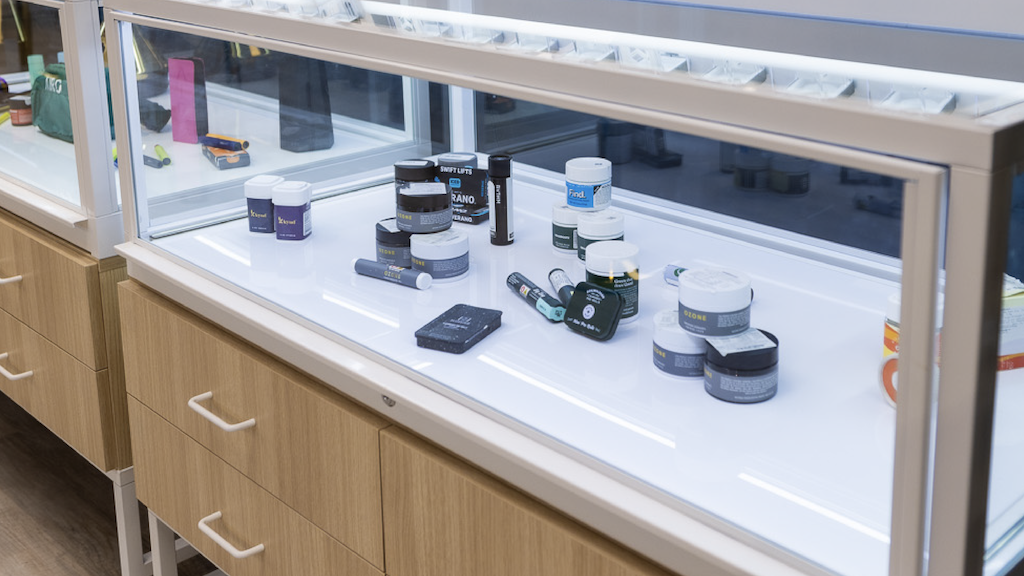THC, CBD, CBN — shopping for cannabis can feel like swimming in alphabet soup sometimes. Let’s throw another important abbreviation into the mix: TAC, also known as total active cannabinoids.
This abbreviation isn’t just a buzzword — it’s a crucial metric that gives you a clear understanding of what to expect from your chosen product. We put this guide together to help you better understand just what TAC is and how to know how it will affect your sesh.
What is TAC in weed?
TAC refers to all the active cannabinoids present in a cannabis product and the amounts of each detected during a laboratory test. This measurement includes phytocannabinoids like delta-9-tetrahydrocannabinol (THC), Cannabidiol (CBD), Cannabigerol (CBG), and others, each of which contributes to the overall potency and effects of the cannabis product you want to buy.
Understanding TAC can help you better choose cannabis products for specific use cases, whether you want to tune in at a party or tune out on the couch. Because all the active cannabinoids in a product work together to produce a unique experience — something called “the entourage effect” — knowing which cannabinoids are present and in what amounts sheds a lot of light on what you can expect.
Which cannabinoids are a part of TAC?
Researchers have identified more than 100 cannabinoids in the cannabis plant, but not all of these are detectable in cannabis testing, and not all cannabinoids are present in all cultivars. Some are considered “minor cannabinoids” too — basically covering any cannabinoid that isn’t THC or CBD. As a result, there are six common cannabinoids that are typically listed as a part of TAC, sometimes referred to as the “Big Six.” These include:
- Tetrahydrocannabinol (THC): The most well-known cannabinoid in cannabis, THC is responsible for the mind-altering and cerebral effects of the plant. It’s typically found in cannabis flower in a range of 10% to 30%.
- Cannabidiol (CBD): The second most well-known cannabinoid, CBD won’t cause any intoxicating effects and may balance out the effects of THC, resulting in a lead heady effect. It may help with various ailments such as anxiety, inflammation, or pain. It can be found in quite a wide range. It may be present in low numbers, around 1% to 2%, or it may not be present at all. Some cultivars (varieties, or strains) bred for higher CBD content can contain much higher amounts.
- Cannabinol (CBN): There’s still a lot of research needed on CBN, but studies suggest that it may be beneficial in reducing pain signals from your body to your brain. It’s also widely embraced for its sedating effects, which is why you’ll see CBN in products formulated for sleep. Most cannabis cultivars contain less than 1% CBN. However, these small levels of CBN may still significantly impact your experience.
- Cannabichromene (CBC): CBC is non-intoxicating, so just like CBD, you won’t feel heady effects when this cannabinoid is center stage. However, it may offer benefits for pain and inflammation. Like CBN, even small percentages of CBC can have a noticeable effect.
- Cannabigerol (CBG): While most cannabis strains only contain about 1% CBG, it’s believed to be a part of a powerful “entourage effect,” especially when combined with CBD. Studies have shown CBG to be potentially beneficial in fighting inflammation and pain.
- Tetrahydrocannabivarin (THCV): One of the lesser-known cannabinoids in the cannabis plant, THCV can cause cerebral effects when consumed in high doses. Like THC, findings show that it may have therapeutic potential in the treatment of certain inflammatory diseases. It has also been found to be an appetite suppressant.
Where is TAC listed on a product label?
You can typically locate the TAC on the product label attached to the packaging. This information is likely to be accompanied by details about when and where the product was tested, as well as information about terpenes and more.
TAC content is generally presented in a table along with a list of the active cannabinoids present and their respective amount (percentages and/or milligram quantities). Some brands may provide QR codes with direct access to the testing results.
What are acidic cannabinoids, and how do they relate to TAC?
Acidic cannabinoids are cannabinoids found in raw, unheated cannabis. The most commonly known acidic cannabinoid is tetrahydrocannabinolic acid (THCA), the precursor to THC. When heated, THCA converts into the active cannabinoid THC.
Because acidic cannabinoids are precursors to active cannabinoids and TAC precisely measures the total content of active cannabinoids, acidic cannabinoids are not included in TAC.
What turns an acidic cannabinoid into an active cannabinoid?
The transformation of acidic cannabinoids into their active counterparts occurs through a process called decarboxylation. This activates the compounds in the plant so that you feel its effects, no matter what those effects may be. In the context of cannabis, the process is typically induced by applying heat, such as through vaporizing or when making homemade edibles.
For example, THCA, in its natural state, possesses an additional carboxyl ring within its chemical structure. When THCA is heated, it loses this carboxyl group and becomes THC. Similarly, CBDA is transformed into CBD through decarboxylation.
THC vs. TAC: understanding the difference
THC is just one of many cannabinoids you’ll find in any given cannabis product. TAC refers to all cannabinoids in a product. So while TAC is inclusive of THC, THC is not inclusive of the TAC or other cannabinoids.
What is a good amount of cannabinoids? Understanding how TAC shapes your session
Cannabis and cannabinoids are not one-size-fits-all. Instead, cannabis consumption is highly personalized, based on factors like your tolerance level, your specific preferences, or your therapeutic goals.
While you might seek out a cultivar with high THC levels for more pronounced cerebral effects, someone else may prioritize CBD precisely because it doesn’t have cerebral effects. The ideal cannabinoid profile ultimately varies from person to person.
To gauge how a product is going to affect you, take note of the TAC each time you use a product. Take note of any effects common to products with similar compound profiles. The more you keep track of how certain cannabinoid profiles affect you, the better you can gauge how new products might affect you too. Consider keeping a cannabis journal when trying new products to try and better match the effects you experience to the cannabinoids (and terpenes) present in each product.
Does TAC stand for anything else?
When dealing with cannabis, there is another type of TAC you might come across as well: “total aerobic count.” It’s important to note that while the acronym is the same, these two TACs represent entirely different measurements and serve quite different purposes.
In the context of the total aerobic count, TAC pertains to microbial testing, and laboratory analysis to assess the presence of microbes like mold or mildew. All cannabis products must be tested per state regulations for total aerobic count to ensure they’re free of contamination before hitting dispensary shelves.
Discover the Queen City’s difference
As you navigate the world of cannabis, seeking out quality products that meet your needs, remember that Queen City dispensary is here to be your trusted companion. With a diverse range of premium products and a commitment to your satisfaction, we invite you to experience cannabis in its finest form. We’re also happy to explain concepts like TAC and anything else you see on the label or in the test results of your cannabis products. Explore our offerings and embark on a personalized adventure with Queen City!


